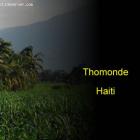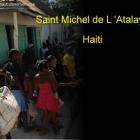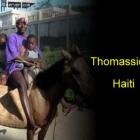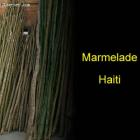ADVERTISEMENT
Haiti
Four Departments in Haiti Risk Falling in Food Crisis
According to the observation of the National Food Security Coordination (CNSA), during the period between April to September 2015, four departments in Haiti, namely, Southeast, Artibonite, North and Northwest my face acute food crisis due to the delay and shortage of rainfalls coupled with the threats of El Nino between April and June. A UN report on April 2014 had suggested that some 1.5 million people may continue to have severe food insecurity in Haiti, mostly as a result of drought and the impact of Hurricanes and storms.
Lack of rainfall often causes near total crop failure in Haiti's impoverished Artibonite, Northwest Department where over 40% of the households are considered food insecure. Bombardopolis, Anse-à-Galets, the upper Artibonite are facing dry periods for more than the last six months. The local farmers harvest 60% of their annual production during the spring time provided it had been watered sufficiently with rainfall and irrigation during the period of plantation and cultivation. Lack of production would further escalate the labor cost and food price higher. Some food species like sweet potato, yams and cassava are simultaneous sources of food and income. Some of the rice producing areas like Artibonite Valley, Saint Raphael and the Plain of Cayes, chemical fertilizers is available, but in very small quantities, a mere 8,000 metric tons annually which is about 25 to 30% of its requirement. The CNSA has estimated that there could be a 50% shortfall of agricultural production, resulting rise in the price of food products unless the situation is properly monitored, especially in the bottom Northwest and some cities in the Southeast where the state of the poor is truly miserable. Irrigation facilities should never entirely depend on rainfall or availability of water, the number of available tractors used in the operation should be more to call sufficient; it should be immediately increased from the present number of 12 in the whole region of the Artibonite Valley.
Mirebalais University Hospital separates Conjoined Twins
University Hospital of Mirebalais (HUM) has delivered a miracle, the successful separation of conjoined twins, the first procedure of its kind in Haiti. Manoucheca Ketan discovered she was going to bear triplets during an ultrasound. It shocked the poverty-stricken mother-to-be, but even more alarming was the news two of the fetuses were conjoined female twins. The pressures were enormous for Ketan, for it was estimated surgery to separate them plus pre- and post-natal care would amount to approximately $100,000.
A relative recommended Ketan get the procedure done at HUM for free. The hospital opened in 2013 and uses cutting-edge technology. HUM's OB-GYN Director, Dr. Christophe Milien, assured Ketan he and the surgery team would do everything possible ". . . to keep these babies alive."
Death in Campech, Belle Ville due to Flooding
On November 19, 2015, five people in one family died in Campech, Belle Ville in Petion-Ville, due to flooding. The administration has taken steps to mobilize resources to help the affected civilians. Flooding is a serious threat to Haiti. During last April, six people died in flooding.
Three of them were from Cite Soleil, a district of Port-au-Prince and three others in Delmas, and Carrefour. As per Directorate of Civil Protection and Interior Ministry's report, 245 families had to be relocated and 8,379 homes were flooded due to overflowing river in April. Some of the big issues after a flooding in Haiti commonly include: deaths and missing people, cholera, damaged crops, livestock killed, non availability of charcoal required for cooking, damages to property, latrine overflow with feces everywhere, life-threatening mudslides in deforested areas.
Noailles Heart of Artistic Masterpieces in Croix-des-Bouquets
Noailles village has become renowned for its artwork, produced from found objects, tossed-out oil drums. To make art objects from rubbish requires great skill and creativity, which Noailles's inhabitants possess in abundance.
The village is an artist's colony. Everyone is involved in making spectacular objects for everyday living: some practical, others decorative. The raw material, iron, is pounded into such usables as mirrors, furniture, and light fixtures. Aesthetic pieces include sculptures and wall hangings.
What characterizes Noailles is the 24/7 sound of metal being molded by chisels and hammers. No one complains to the local police about the clank and clang of ringing metal, which can be heard up to a mile away. Quite the opposite. The townspeople regard the sounds of metal on metal as ". . . welcome, beautiful even; music to the ears of all who live (in Noailles)"
Co-ops Light in Coteaux and Roche-a-Bateau
NRECA (National Rural Electric Cooperative Association) International provides people in developing countries with access to safe, reliable and affordable electricity. The company is credited with the establishment of Haiti's first electric cooperative-- Cooperative Electrique de l'Arrondisement des Coteaux (CEAC). Dozens of volunteer cooperative linemen are working tirelessly to connect homes in Côteaux and Roche-a-Bateau to the power grid and a third community, Port-a-Piment, will be also connected to the grid by this year end. During inauguration ceremonies, on September 10 and 18, the residents of Côteaux and Roche-a-Bateau cheered with joys as they saw the streetlights glowing for the first time. At present, the cooperative has more than 670 registered members and intends to serve 1,600 or more consumers in three towns. The project has been made possible with support from the USAID, the United Nations Environmental Program (with financing from the Norwegian government), the Inter-American Development Bank, and the NRECA International Foundation. The cooperative needs different varieties of volunteers to serve.
Haiti President of the UNWTO Commission for the Americas
On Saturday, September 12, 2015, during the 59th Meeting of the Regional Commission for the Americas (CAM) of the UNWTO (United Nations World Tourism Organization) between September 11 and 16 at Medellín, the second-largest city in Colombia, in the presence of Stéphanie Villedrouin, the Minister of Tourism and Creative Industries and important members of the Haitian delegation, 26 member countries have unanimously elected Haiti as the President of the Commission for two consecutive terms (2015-2017).
The meeting was a part of the 21st General Assembly of the World Tourism Organization. The Haitian delegation present in the meeting also took part in a high-level forum conducted jointly by the UNWTO and the Office of the International Civil Aviation Organization (ICAO), on a theme of "Tourism and Transport for Development". Stéphanie Villedrouin met various personalities for possible partnership on creative industries.
Oxfam Report: Haiti Mining Laws Need Strengthening
Haiti's gold, silver, and copper resources exploitation challenges.
International agency, Oxfam, has released a report concerning development of Haiti's gold, silver, and copper lodes in northern Haiti. The thrust of the report states ". . . governance and regulatory challenges . . ." must be met prior to developing the precious metals. According to the report, doubts exist Haiti can manage its mining sector responsibly and successfully.
The windfall from mining revenues have the possibility to help Haiti build its infrastructure, but unless the Haitian government takes measures to guarantee revenues are protected, and will benefit communities, corruption will wipe out whatever good was intended for poverty-stricken Haiti.
Tax Office, Municipal Palace, Vice Delegates Office in Arcahaie Burned
For the past seven weeks, the representatives from the Interior Ministry and representatives from the local administration and residents of Arcahaie have met several times to resolve a crisis which has stalled the normalcy of their city life. People are agitating against a Presidential decree which they believe is unconstitutional; an act ultra vires the power of an outgoing caretaker President of the nation who is holding his office by a decree, without any parliament.
They are not satisfied with President Martelly's decision to make "Les Arcadins" a separate commune and connected it to the Artibonite Department. The new commune will take out a part of beautiful coastline from Arcahaie city where the President has built a multimillion dollar mansion for himself and few more homes for his friends. Since the first day of September, People are showing their mark of displeasure by a series of activities. They have shattered and burnt three passenger buses, a dozen of motorcycles were set on fire during a protest on the Route National 1. People cannot travel between north and south; even the people from the east cannot travel back from Port-au-Prince. On October 2nd, three public buildings, such as, the tax office, the municipal palace and the vice delegates office for the district in Arcahaie, were set on fire. The school students of Arcahaie could not attend their classes since the commencement of 2015-16 session.
Population Set Fire to Customs Building in Anse-A-Pitre
The tension on the Haitian side of the Dominican border reached a new high on October 12th when the Haitian authority in the town of Anse-à-Pitre attempted to confiscate and apply restrictive measures on the 23 banned items, including many of the basic necessities for the Haitian population.
Anse-à-Pitre is a town near the border with Pedernales where goods are transported to the binational market by taxis and motorcycles. The population had reacted strongly and a spontaneous demonstration was formed immediately who set fires on the customs building and motorcycle tyres and threw stones to the police; gun shots were reported. It has been decided that two Presidents, Haitian and Dominican, will meet on Tuesday (October 13th) at the request of Haiti, in the province of Barahona to discuss and resolve the ban crisis.
Baille Tourible in Thomonde Region of Central Plateau
Central plateau is one of the poorest regions in Haiti. Baille Tourible is a small town, surrounded by mountains, in the third communal section of Thomonde. The village is populated by 12,000 inhabitants.
Here water is a part of the luxury goods. This village is one of the very few places that have been spared from mass deforestation. Deforestation causes erosion and it has severely affected the agricultural production in the central plateau. KANPE is a foundation that works for the most vulnerable families in Haiti who are in extreme poverty; it helps them to achieve their individual financial autonomy. They work in the central plateau taking one village at a time.
Our objective is to share with you news and information about Haiti and the people of Haiti. Traditions, habits and the way we were or grew are alive in this site. We highly recommend that you Subscribe to our Newsletter and also share with us some of the things that are memorable and made us unique people.

 Thomonde, Haiti
Thomonde, Haiti  Saint Michel de L 'Atalaye
Saint Michel de L 'Atalaye  Thomassique, Haiti
Thomassique, Haiti  Newsletter
Newsletter  Marmelade, Haiti
Marmelade, Haiti